A guide to hallucinogenics should you fall down the rabbit hole.... Go ask Alice, when she is 10feet tall.
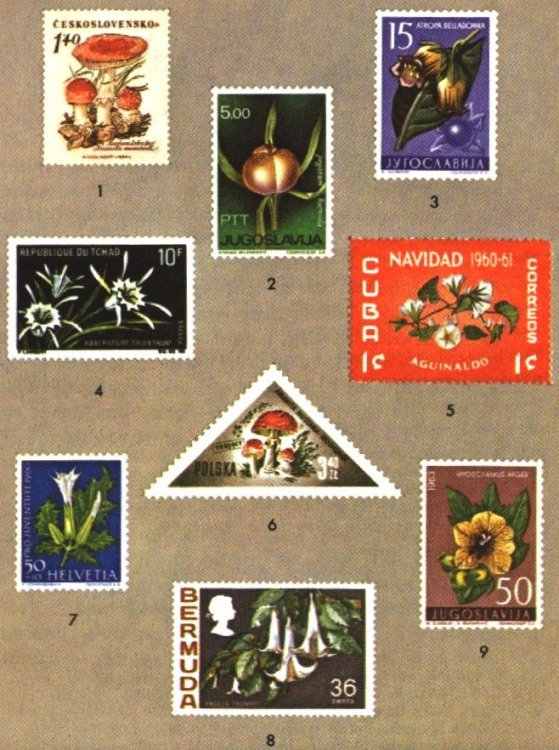
Hallucinogenic plants have been featured on many postage stamps: (1, 6) Amanita muscaria, (2) fruit of Peganum harmala, (3) Atropa belladonna, (4) Pancratium trianthum, (5) Rivea corymbosa, (7) Datura stramonium, (8) Datura candida, (9) Hyoscyamus niger.
WHAT ARE HALLUCINOGENIC PLANTS?
In his search for food, early man tried all kinds of plants. Some nourished him, some, he found, cured his ills, and some killed him. A few, to his surprise, had strange effects on his mind and body, seeming to carry him into other worlds. We call these plants hallucinogens, because they distort the senses and usually produce hallucinations - experiences that depart from reality. Although most hallucinations are visual, they may also involve the senses of hearing, touch, smell, or taste - and occasionally several senses simultaneously are involved.
The actual causes of such hallucinations are chemical substances in the plants. These substances are true narcotics. Contrary to popular opinion, not all narcotics are dangerous and addictive. Strictly and etymologicolly speaking, a narcotic is any substance that has a depressive effect, whether slight or great, on the central nervous system.
Narcotics that induce hallucinations are variously called hallucinogens (hallucination generators), psychotomimetics (psychosis mimickers), psychotaraxics (mind disturbers), and psychedelics (mind manifesters). No one term fully satisfies scientists, but hallucinogens comes closest. Psychedelic is most widely used in the United States, but it combines two Greek roots incorrectly, is biologically unsound, and has acquired popular meanings beyond the drugs or their effects.
In the history of mankind, hallucinogens have probably been the most important of all the narcotics. Their fantastic effects made them sacred to primitive man and may even have been responsible for suggesting to him the idea of deity.
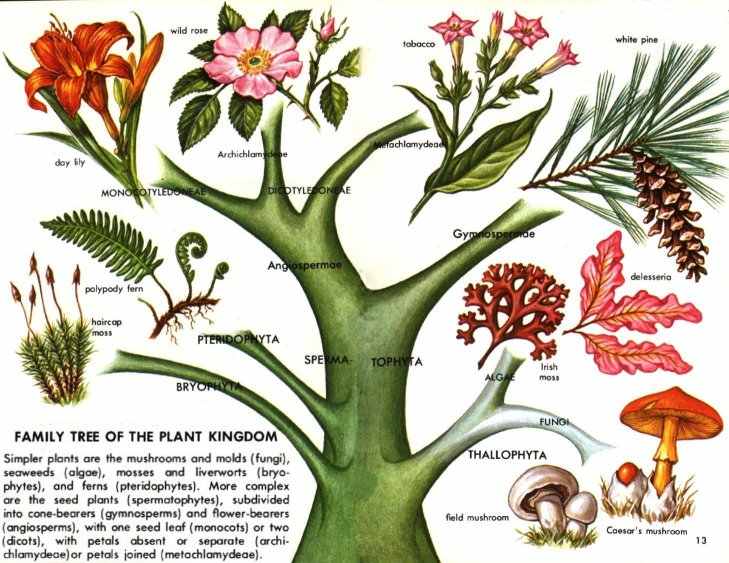
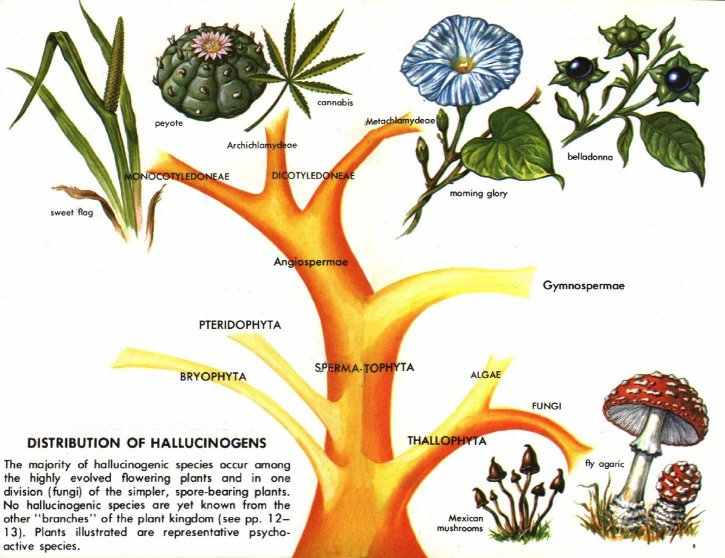
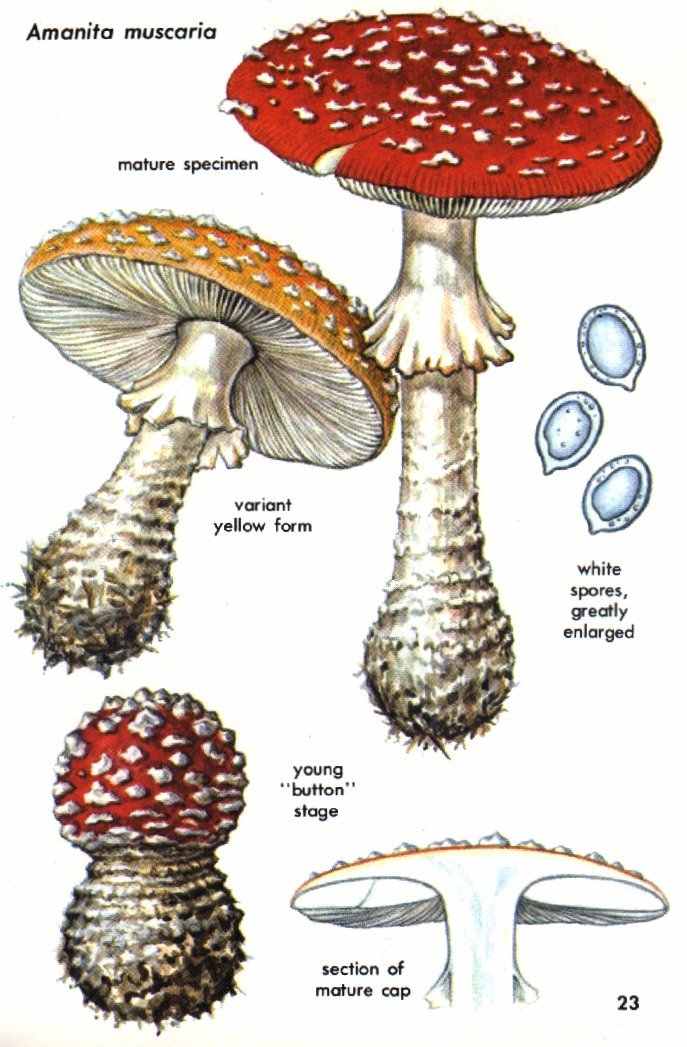 The nature of the intoxication varies, but one or several mushrooms induce a condition marked usually by twitching, trembling, slight convulsions, numbness of the limbs, and a feeling of ease characterized by happiness, a desire to sing and dance, colored visions, and macropsia (seeing things greatly enlarged). Violence giving way to a deep sleep may occasionally occur. Participants are sometimes overtaken by curious beliefs, such as that experienced by an ancient tribesman who insisted that he had just been born! Religious fervor often accompanies the inebriation.
The nature of the intoxication varies, but one or several mushrooms induce a condition marked usually by twitching, trembling, slight convulsions, numbness of the limbs, and a feeling of ease characterized by happiness, a desire to sing and dance, colored visions, and macropsia (seeing things greatly enlarged). Violence giving way to a deep sleep may occasionally occur. Participants are sometimes overtaken by curious beliefs, such as that experienced by an ancient tribesman who insisted that he had just been born! Religious fervor often accompanies the inebriation. Recent studies suggest that this mushroom was the mysterious God- narcotic soma of ancient India. Thousands of years ago, Aryan conquerors, who swept across India, worshiped some, drinking it in religious ceremonies. Many hymns in the Indian Rig-Veda are devoted to soma and describe the plant and its effects.
The use of soma eventually died out, and its identity has been an enigma for 2,000 years. During the past century, more than 100 plants have been suggested, but none answers the descriptions found in the many hymns. Recent ethnobotanicol detective work, leading to its identification as A. muscaria, is strengthened by the reference in the vedas to ceremonial urine drinking, since the main intoxicating constituent, muscimole (known only in this mushroom), is the sole natural hallucinogenic chemical excreted unchanged from the body.
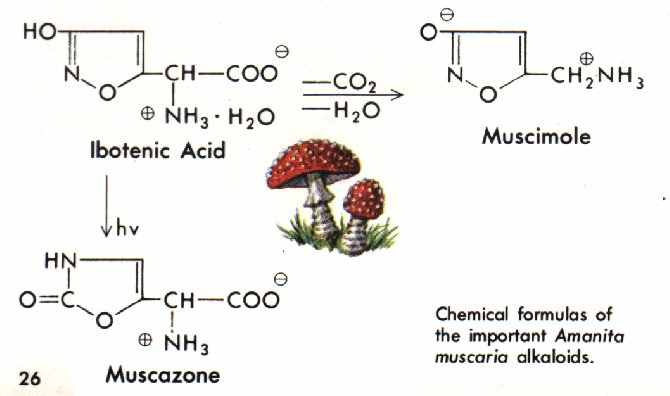
Fly agaric mushroom is so called because of its age-old use in Europe as a fly killer. The mushrooms were left in an open dish. Flies attracted to and settling on them were stunned, succumbing to the insecticidal properties of the plant.

The name belladonna ("beautiful lady" in Italian) comes from a curious custom practiced by italian women of high society during medieval times. They would drop the sap of the plant into the eye to dilate the pupil enormously, inducing a kind of drunken or glassy stare, considered in that period to enhance feminine beauty and sensuality.
The main active principle in belladonna is the alkaloid hyoscyamine, but the more psychoactive scopolamine is also present. Atropine has also been found, but whether it is present in the living plant or is formed during extraction is not cleor. Belladonna is a commercial source of atropine, an alkaloid with a wide variety of uses in modern medicine, especially as an antispasmodic, an antisecretory, and as a mydriatic and cardiac stimulant. The alkaloids occur throughout the plant but are concentrated especially in the leaves and roots.
There are four species of Atropa distributed in Europe and from central Asia to the Himalayas. Atropa belongs to the nightshade family, Solanaceae. Belladonna is native to Europe and Asia Minor. Until the 19th century, commercial collection was primarily from wild sources, but since that time cultivation has been initiated in the United States, Europe, and India, where it is an important source of medicinal drugs.
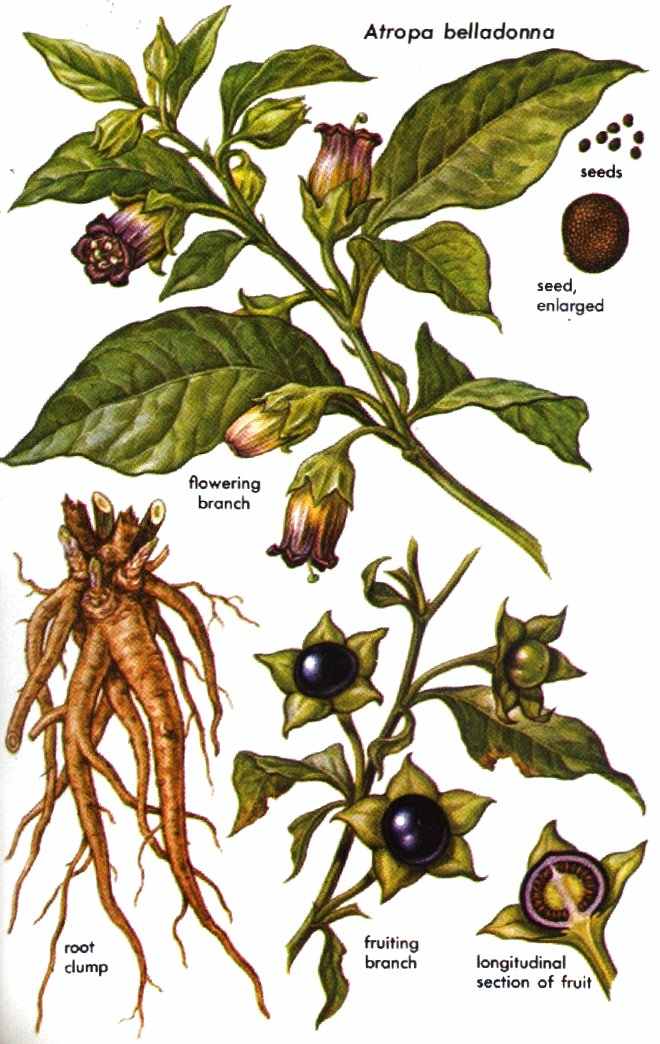
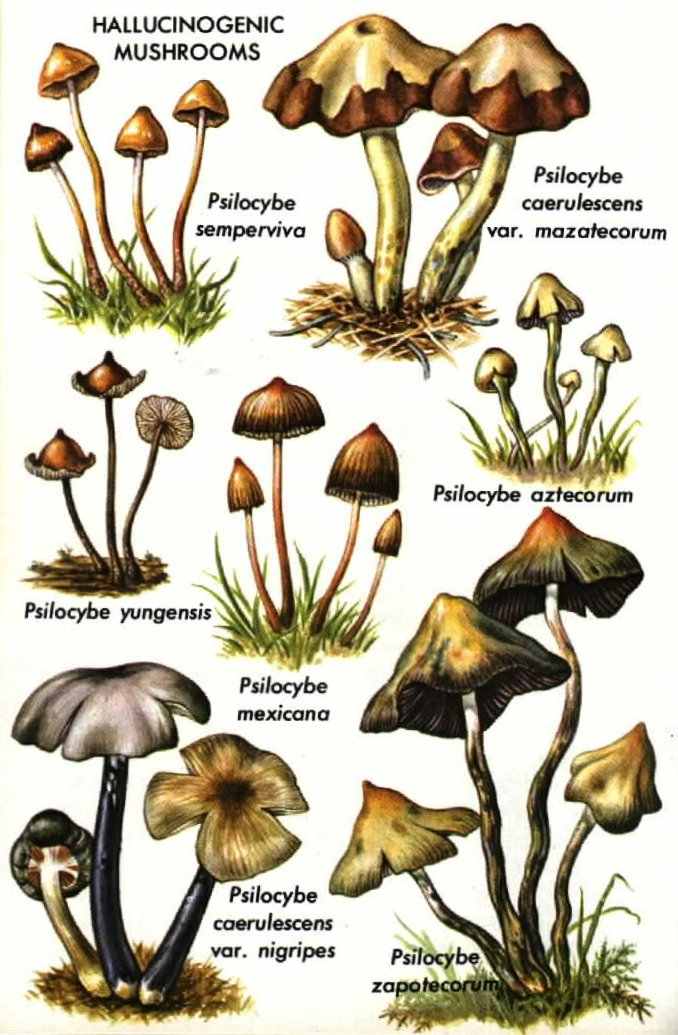
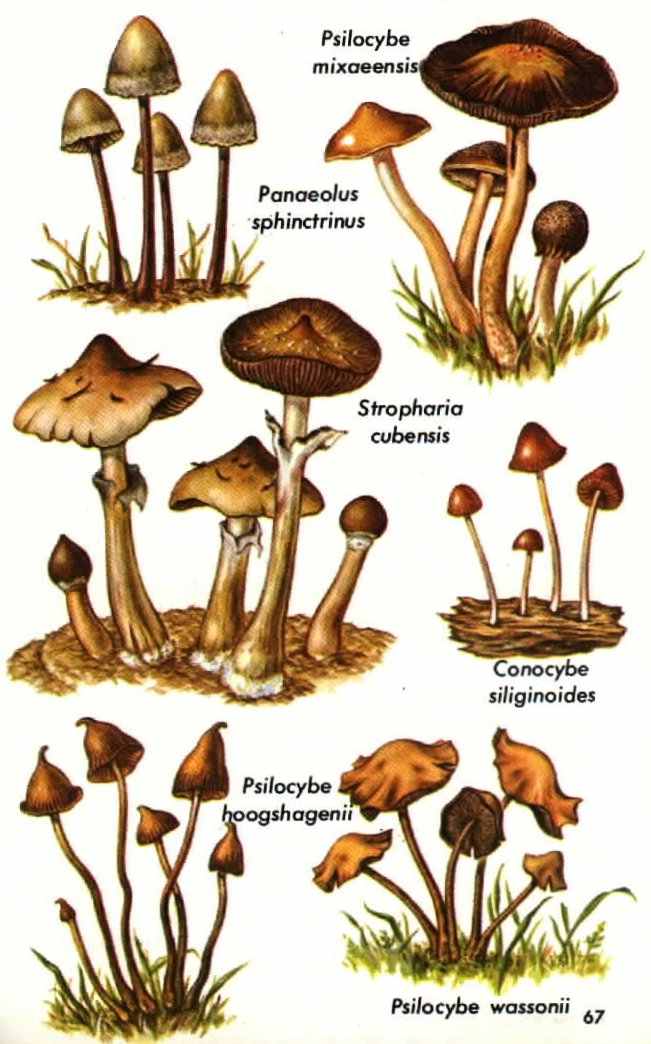

One investigator who ate mushrooms in a Mexican Indian ceremony wrote that "your body lies in the darkness, heavy as lead, but your spirit seems to soar . . . and with the speed of thought to travel where it listeth, in time and space, accompanied by the shaman's singing . . . What you are seeing and . . . hearing appear as one; the music assumes harmonious shapes, giving visual form to its harmonies, and what you are seeing takes on the modalities of music--the music of the spheres.
"All your senses are similarly affected; the cigarette . . . smells as no cigarette before had ever smelled; the glass of simple water is infinitely better than champagne . . . the bemushroomed person is poised in space, a disembodied eye, invisible, incorporeal, seeing but not seen . . . he is the five senses disembodied . . . your soul is free, loses all sense of time, alert as it never was before, living an eternity in a night, seeing infinity in a grain of sand . . . (The visions may be of) almost anything . . . except the scenes of your everyday life." As with other hallucinogens, the effects of the mushrooms may vary with mood and setting.
Peyote was first described botanically in 1845 and called Echinocactus williamsii. It has been given many other technical names. The one used most commonly by chemists has been Anhalonium lewinii. Most botanists now agree peyote belongs in a distinct genus, Lophophora. There are two species: the widespread L. williamsii and the local L. diffusa in Querétaro.
Peyote is native to the Rio Grande valley of Texas and northern and central parts of the Mexican plateau. It belongs to the cactus family, Cactaceae, comprising some 2,000 species in 50 to 150 genera, native primarily to the drier parts of tropical America. Many species are valued as horticultural curiosities, and some have interesting folk uses among the Indians.

USE OF PEYOTE BY THE AZTECS was described by Spanish chroniclers. One reported that those who ate it saw frightful visions and remained drunk for two or three days; that it was a common food of the Chichimeca Indians, "sustaining them and giving them courage to fight and not feel fear nor hunger nor thirst; and they say that it protects them from all danger." In 1591, another chronicler wrote that the natives who eat it "lose their senses, see visions of terrifying sights like the devil, and are able to prophesy their future with 'satanic trickery.' "
Dr. Hernández, the physician to the King of Spain, described the cactus as Peyotl zacatecensis and wrote of its "wonderful properties." He took note of its small size and described it by saying that "it scarcely issues from the earth, as if it did not wish to harm those who find and eat it." Recent archaeological finds of peyote buttons in the state of Texas are approximately 1 ,000 years old.
OPPOSITION TO THE USE OF PEYOTE by the Aztecs was strong among the Spanish conquerors. One early Spanish church document likened the eating of peyote to cannibalism. Upset by the religious hold that peyote had on the Indians, the Spanish tried, with great vigor but little success, to stamp out its use.
By 1720, the eating of peyote was prohibited throughout Mexico. But despite four centuries of civil and ecclesiastical persecution, the use and importance of peyote have spread beyond its early limited confines. Today it is so strongly anchored in native lore that even Christianized Indians believe that a patron saint--El Santo Niño de Peyotl--walks on the hills where peyote grows.
There is continuing opposition in certain religious organizations in the United States to the Indians' use of peyote as a ceremonial sacrament. Nevertheless, the federal government has never seriously questioned or interfered with the practice since it is essentially a religious one. Those tribes living far from sources of peyote--some as far north as Canada--can legally import mescal buttons by mail. Despite constitutional guarantees separating church and state, however, a few states have enforced repressive laws against even the religious use of peyote.
EFFECTS OF PEYOTE on the mind and body are so utterly unworldly and fantastic that it is easy to understand the native belief that the cactus must be the residence of spirit forces or a divinity. The most spectacular of the many effects is the kaleidoscopic play of indescribably rich, colored visions. Hallucinations of hearing, feeling, and taste often occur as well.
The intoxication may be divided into two periods: one of contentment and extrasensitivity, followed by artificial calm and muscular sluggishness at which time the subject begins to pay less attention to his surroundings and increase his introspective "meditation.' Before visions appear, some three hours after eating peyote, there are flashes and scintillations in colors, their depth and saturation defying description. The visions often follow a sequence from geometric figures to unfamiliar and grotesque objects that vary with the individual.
Though the colored visual hallucinations undoubtedly underlie the rapid spread of the use of peyote, especially in those Indian cultures where the quest for visions has always been important, many natives assert that visions are "not good" and lack religious significance. Peyote's reputation as a panacea and all-powerful "medicine" - both in physical and psychic sense - may be equally responsible for its spread.
USE OF PEYOTE IN THE UNITED STATES first came to public attention about 1880 when the Kiowa and the Comanche Indians established a peyote ceremony derived from the Mexican but remodeled into a visionquest ritual typical of the Plains Indians. Use of peyote had been recorded earlier, in 1720, in Texas. How the use of peyote diffused from Mexico north, far beyond the natural range of the cactus, is not fully known. During the 1880's, many Indian missionaries were active in spreading the peyote ceremony from tribe to tribe. By 1920, the peyote cult numbered over 13,000 faithful in more than 30 tribes in North America. It was legally organized, partly for protection against fierce Christian - missionary persecution, into the Native American Church, which now claims 250,000 members. This cult, a combination of Christian and native elements, teaches brotherly love, high moral principles, and abstention from alcohol. It considers peyote a sacrament through which God manifests Himself to man.
......Smoking daffodils........
excerpts from: Golden Guide to Hallucinogenics
No comments:
Post a Comment